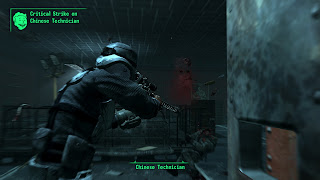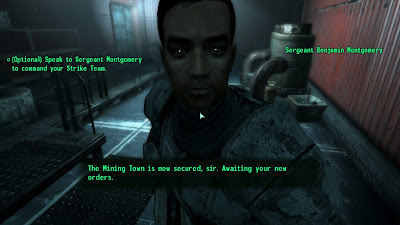Fallout 3
 |
| Source: http://upload.wikimedia.org/wikipedia/en/8/83/Fallout_3_cover_art.PNG |
This week I will be discussing one of my favourite games, fallout 3. Fallout 3 was published by Bethesda Softworks and ZeniMax Media in 2008. Fallout utilizes the Havok physics engine which lends itself to realistic animations of characters and what not. But we will begin with the interface design.
In Fallout 3 you interface with the world through a PIP-Boy 3000, a device strapped to your wrist that as provides you with all the crucial information you need (quests, status, inventory). What's interesting about the PIP-Boy is that it is not a static menu, it is actually 3D rendered and will animate as you use it.
In Fallout 3 you interface with the world through a PIP-Boy 3000, a device strapped to your wrist that as provides you with all the crucial information you need (quests, status, inventory). What's interesting about the PIP-Boy is that it is not a static menu, it is actually 3D rendered and will animate as you use it.
Facial Animation Facial animation is an integral part of the game and it accomplishes its purpose well enough. As you speak to the character the camera moves into a portrait of their upper body. If I really think about it , the facial animations are a little jarring. The mouth is the only part of the face that animates most of the time with only other parts of the face (like eyes and cheek) contouring for extreme emotions (change to anger, or fear). It almost looks a little robotic.
This still also demonstrates some of the lighting and shaders present in Fallout 3. As you can see this takes place in a dark bunker with the only light source. You can see the reflection of the light in the characters pupils, and this is especially noticeable in dark locations.
VATS

 Fallout 3 utilizes a strategic targeting system called VATS (Vault - Tech Assisted Targeting System) which allows a player to select various locations on an enemy to target. That area is then highlighted (presumably with a shader) and the probability of hitting is displayed. After all areas are selected the game proceeds to go into a cinematic, slow motion camera view that shows your shots in ll their glory. One thing that I did notice is the stiffness of the main models when they are "alive". There aren't really a lot of idle animations for them so when they change states from idle to walking it is quite sudden. Anyways, when a character is "killed" the model turns into a ragdoll and depending on the geometry in the environment some really
Fallout 3 utilizes a strategic targeting system called VATS (Vault - Tech Assisted Targeting System) which allows a player to select various locations on an enemy to target. That area is then highlighted (presumably with a shader) and the probability of hitting is displayed. After all areas are selected the game proceeds to go into a cinematic, slow motion camera view that shows your shots in ll their glory. One thing that I did notice is the stiffness of the main models when they are "alive". There aren't really a lot of idle animations for them so when they change states from idle to walking it is quite sudden. Anyways, when a character is "killed" the model turns into a ragdoll and depending on the geometry in the environment some really  physics defying things occur. This does not only apply to the non player characters but the player character itself which can be viewed by zooming out with the scroll wheel. The camera then changes to an isometric perspective and follows the torso of the player.
physics defying things occur. This does not only apply to the non player characters but the player character itself which can be viewed by zooming out with the scroll wheel. The camera then changes to an isometric perspective and follows the torso of the player. The environment of Fallout 3 utilizes a numerous amount of animations to make it come to life. For instance, the clouds are sprites but on a separate layer the background (parallax), giving an illusion of depth. This specific area in the game is actually dlc, but nonetheless is a good demonstration of other animation effects. For instance, in the larger picture below you can see some snow falling, because this level takes place in arctic-like conditions. The snow is a dynamic particle system that also reacts to winds blowing in the area. On the ground there are also "dust(snow)-devils" generated which give the feeling of a barren and desolate landscape.
The environment of Fallout 3 utilizes a numerous amount of animations to make it come to life. For instance, the clouds are sprites but on a separate layer the background (parallax), giving an illusion of depth. This specific area in the game is actually dlc, but nonetheless is a good demonstration of other animation effects. For instance, in the larger picture below you can see some snow falling, because this level takes place in arctic-like conditions. The snow is a dynamic particle system that also reacts to winds blowing in the area. On the ground there are also "dust(snow)-devils" generated which give the feeling of a barren and desolate landscape. Objects in the environment are also animated, take for example the flaming barrel below. The flames are created via the in-game particle system and simultaneously act as light source, as you can see reflecting off the ground and a little on the barrel. Additionally there are glowing objects in this specific level that indicate said object can be interacted with, which like a lot of things in the game, use a shader to give it that nice orange hue.
Objects in the environment are also animated, take for example the flaming barrel below. The flames are created via the in-game particle system and simultaneously act as light source, as you can see reflecting off the ground and a little on the barrel. Additionally there are glowing objects in this specific level that indicate said object can be interacted with, which like a lot of things in the game, use a shader to give it that nice orange hue.


No comments:
Post a Comment